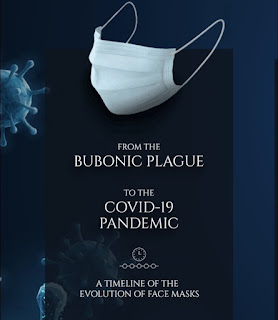In this review, we describe the history of masks from the ... if wound infections could be reduced by the use of surgical ... Masks...
About bubonic plague,
Bubonic plague is the most common form of the disease that people can get. The name comes from the symptoms it causes - painful, swollen lymph nodes or 'buboes' in the groin or armpit.
From 2010 to 2015 there were 3,248 cases reported worldwide, including 584 deaths.
Historically, it has also been called the Black Death, in reference to the gangrenous blackening and death of body parts, such as the fingers and toes, that can happen with the illness.
Let's drive into the topic,
Evolution of face masks,
Medical professionals from the time wore beak-like mask coupled with black coats and dark hats .
To treat patients suffering from the bubonic plague these masks were supposedly filled with Herbs such as clove,Cinnamon to combat contagion carried by bad air .
19 century in Europe,
The introduction of antiseptics by Joseph Lister led to a revolutionary discourse about wound, infections and containment .
His Discovery was significant in the introduction of mouth and nose coverage such as mouth protection face masks and mouth bandages.
Treating the the pneumonic plague,
About pneumonic plague,
Pneumonic plague is a severe lung infection caused by the bacterium Yersinia pestis. Symptoms include fever, headache, shortness of breath, chest pain, and cough.
They typically start about three to seven days after exposure.
It is one of three forms of plague, the other two being septicemic plague and bubonic plague.
Symptoms: Fever, headache, shortness of breath, cough
Causes: Yersinia pestis
Treatment: Antibiotics
Risk factors: Rodents.
Treating the pneumonic plague,
Till 1910 the application of face masks was not common in surgery and hospitals.
In the same year an epidemic of pneumonic plague stuck manchuria,
to prevent it spread physician wu lien-teh developed mask to be worn by medical professionals and general public.
The Spanish flu made masks mandatory for all,
Before 1918 the use of face masks was restricted to the confines of the operating room.
However the Spanish flu brought a new era in history of face masks ,
when for the first time doctors, patients and residents in America Where are asked to wear the masks.
Britons adapt "smog masks",
First World War II London was choking with air pollution,
this lead Britons to adapt "smog masks" to save themselves from the hazardous air, while smog mask became popular among public in 1940 washable and sterilizable masks gained acceptance in international surgery.
Face marks today,
While smog masks Reached developing countries like India and China with rising industrialisation and economic activities .
the demand for face marks has only being fuelled with ongoing corona virus.
face marks and 3D printing surgical shields have became the 21st century questions of ruling bandages.
Now let's get into howdy words which makes us conundrum,
Cinnamon--Cinnamon is a spice obtained from the inner bark of several tree species from the genus Cinnamomum.
Contagion--the communication of disease from one person or organism to another by close contact.
Containment--the action of keeping something harmful under control or within limits.
"the containment of the epidemic".
Confines-- keep or restrict someone or something within certain limits of (space, scope, or time).
Britons--native or inhabitant of Great Britain, or a person of British descent.
Sterilization--the process of making something free from bacteria or other living microorganisms.
At last if you have any queries please mention in the comment box as well as please subscribe it.







Comments
Post a Comment
If you have any questions, please mention in comment box